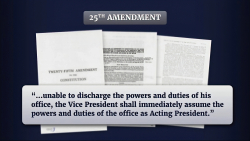
The Pentagon’s Insane Plan to Nuke the Moon
Soviet success with Sputnik initially prompted the US military to consider the detonation of a nuclear weapon on the moon’s surface.
One of the more memorable scenes from the Austin Powers film series was when Dr. Evil (portrayed by Mike Myers) threatens to destroy Washington, DC with “giant freaking lasers” fired from the moon’s surface unless the American president pays him a massive ransom.
The US president (portrayed by Tim Robbins) suggests nuking the moon, prompting him to ask his staff, “Would you miss it?” Well, it turns out that the scene was not far removed from a real plan explored by the Pentagon during the Cold War.
The Crazy Plot to Blow Up the Moon
Known as Project A119, this classified initiative was conceived by the United States Air Force (specifically the Air Force’s Special Weapons Center at Kirtland Air Force Base, New Mexico), which aimed to detonate a nuclear bomb on the moon’s surface as a bold demonstration of American technological and military superiority over the Soviet Union.
The manic obsession with “bold gestures” by the US military at this time was a result of having lost the initial round in the Space Race to the Soviets, after Moscow had successfully placed the first man-made satellite, Sputnik, into Earth’s orbit.
Fear gripped the minds of US policymakers, who believed that it was only a matter of time before the Soviets placed weapons in orbit and threatened a defenseless America from above. Therefore, to reassert their military might, the military wanted to blow up a section of the moon.
To provide a veneer of legitimacy, the Air Force proclaimed that detonating a nuclear weapon on the lunar surface was a “scientific” endeavor. You see, the Pentagon just wanted to study the lunar surface and the effects of a nuclear weapon in a low-gravity vacuum environment.
Some scientists argued that by studying the seismic effects of the explosion, which could reveal insights into the moon’s internal structure, they would gain a deeper understanding of how the moon was formed. Left unsaid or even thought of, though, was that the moon might very well have disintegrated under the explosive might of the warhead, which really would have shown the Russians who was boss, one supposes.
It also would have meant that many inland areas of the world would have suddenly become waterfront properties (considering that the moon controls the tide on Earth).
The blast was expected to create a visible flash and dust cloud, potentially observable from Earth with telescopes, providing data on lunar soil composition and the behavior of particles in a vacuum. Oh, and the mission could have gone awry by having the nuclear warhead accidentally crash back to Earth.
Dr. Strangelove—in Space
The planning for Project A119 involved a team of scientists, including physicist Leonard Reiffel, who led the project at the Armor Research Foundation (now part of the Illinois Institute of Technology). The team conducted feasibility studies to determine the logistics of delivering a nuclear warhead to the moon.
The bomb proposed for the mission was a small nuclear device, roughly equivalent in yield to the Hiroshima bomb (approximately 15 kilotons of TNT). The warhead would be carried by a rocket, likely a modified intercontinental ballistic missile (ICBM), and detonated upon impact or at a low altitude above the lunar surface.
As Project A119 progressed, it became clear that the risks and ethical dilemmas outweighed the potential benefits. Detonating a nuclear bomb on the moon would have caused irreversible damage to the lunar environment, potentially contaminating it with radioactive material.
Such an act could have hindered future scientific exploration, including the Apollo missions that would later land humans on the moon. The international backlash, too, would have been severe, as the act would have been viewed as the overt militarization of space, violating the spirit of peaceful exploration.
Would You Miss the Moon?
By 1959, as the shock of the Sputnik moment wore off and America righted itself on space policy, Project A119 was quietly shelved. The technical risks, combined with the growing emphasis on peaceful space exploration—and the whole, you know, destroying the moon bit—made this bizarre Cold War project less appealing to US policymakers. The establishment of NASA in 1958 immediately shifted US priorities in space toward civilian-led projects rather than militarized ones, culminating in the Apollo program.
Additionally, the signing of the Partial Test Ban Treaty in 1963, which prohibited nuclear explosions in space, would have made such a project illegal.
Project A119 remained classified until the 1990s, when declassified documents and accounts from individuals, like Leonard Reiffel, brought it to public attention. The revelation sparked renewed interest in the Cold War’s more outlandish schemes and prompted reflection on the ethical boundaries of scientific and military endeavors.
Project A119 is also a reminder of the importance assigned to symbolic victories (however spurious) during the Cold War.
About the Author: Brandon J. Weichert
Brandon J. Weichert, a Senior National Security Editor at The National Interest as well as a contributor at Popular Mechanics, consults regularly with various government institutions and private organizations on geopolitical issues. Weichert’s writings have appeared in multiple publications, including The Washington Times, National Review, The American Spectator, MSN, The Asia Times, and countless others. His books include Winning Space: How America Remains a Superpower, Biohacked: China’s Race to Control Life, and The Shadow War: Iran’s Quest for Supremacy. His latest book, A Disaster of Our Own Making: How the West Lost Ukraine, is available for purchase wherever books are sold. He can be followed on Twitter @WeTheBrandon.
Image: Maxal Tamor / Shutterstock.com.
The post The Pentagon’s Insane Plan to Nuke the Moon appeared first on The National Interest.















